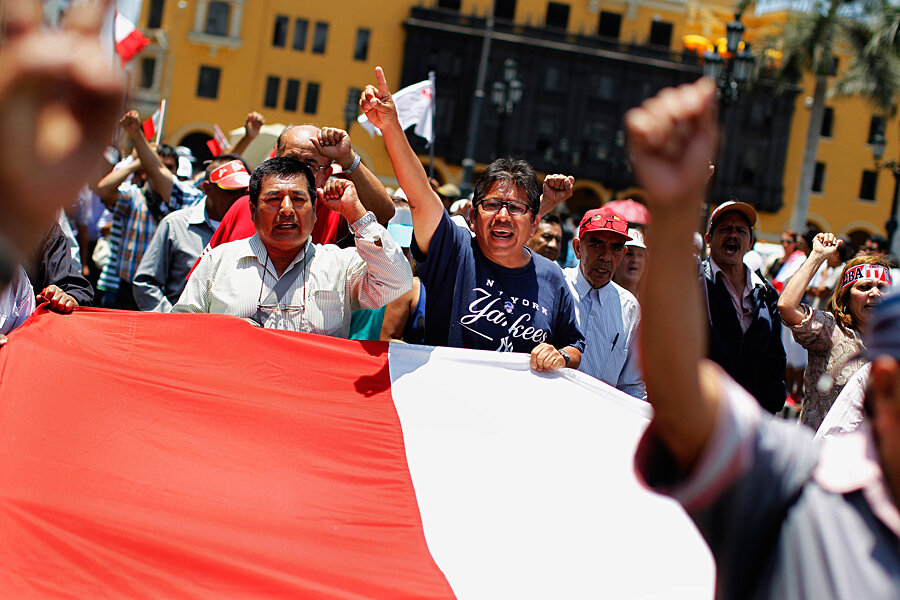Who 'wins' in Peru-Chile maritime border ruling?
Loading...
| THE HAGUE, Netherlands
The United Nations' highest court drew a new maritime boundary between Peru and Chile on Monday, awarding Peru parts of the Pacific Ocean but keeping rich coastal fishing grounds in Chilean hands.
The line drawn by the International Court of Justice ended decades of debate about how to carve up some 38,000 square kilometers (14,670 square miles) of fish-rich waters off the coasts of the Latin American neighbors. Peru's fishing industry estimates the annual catch in the region to be worth some US$200 million.
Peru wanted a maritime border heading roughly southwest, perpendicular to the point where the two countries' land border meets the ocean. Chile insisted the border should extend from the coast parallel to the equator.
The court found a compromise by saying a border already existed parallel to the equator extending 80 nautical miles from the coast and then drawing a line southwest to a point where the countries' 200-mile territorial waters end.
In Lima, President Ollanta Humala had no immediate reaction.
Outside the presidential palace, scores of people who had watched the verdict being read on two giant TV screens shouted "Long Live Peru" afterward, though there was some confusion as to whether their country had won or lost.
In the Peruvian border city of Tacna, a few hundred people from a patriotic society who had gathered in a movie theater to watch the ruling sang the national anthem. Dozens of police guarded the Chilean consulate but there were no incidents.
A professor of international relations at Lima's Catholic University, Farid Kahhat, said Peru had won a bit more than half the territory it sought.
But the leader of the Peruvian fishermen in the region, David Patino, told The Associated Press that the decision was a loss.
"We haven't won anything. We are in the same situation as the past," he said.
After Peru, Chile is the world's No. 2 exporter of fish meal.
Peruvian historian and columnist Nelson Manrique called the decision an "intelligent verdict" that is "not going to please anyone but it's also not going to bring anyone to fits."
Patricia Majluf, a leading Peruvian fisheries scientist, said the area up to 80 miles (128 kilometers) that remains in Chilean hands "is where the Chilean boats fish the most" and she doesn't expect the verdict will cost the job of any Chilean fisherman.
"All the anchoveta is fished in that zone," she said. The anchovy species is converted into fish meal for an insatiable global market that uses it in animal feed and fertilizer.
Majluf, a professor at Cayetano Heredia University in Lima, said about 1 million tons of anchoveta are harvested annually off the northern Chile coast. That's about the same amount as off the southern Peruvian coast, she added.
For many, the case launched in 2008 by Peru is a matter of national pride. Chile seized its three northernmost provinces during the 1879-83 War of the Pacific from Peru and Bolivia, which lost its only coast in the conflict.
The actual border area has long been a model of coexistence. Citizens of both countries travel freely between Arica and its Peruvian sister city of Tacna, both of which depend on the fishing industry and on each other.
Chileans crowd into Tacna's hospitals and clinics for the cheaper health care, while Peruvians work construction and other day jobs on the Chilean side of the border. Arica's mayor, Salvador Urrutia, says some 5,000 people cross the border in both directions each day.
Rulings by the court are final and binding on both countries. The presidents of Peru and Chile each pledged to adhere to whatever decision the court made. The countries are partners in a number of important regional and Pacific economic alliances and have seen annual bilateral trade grow from $500 million in 2006 to $4.3 billion today and each had significant investments in the other in sectors as diverse as tourism, retail and gastronomy.
Chilean government figures put Peruvian investment in Chile at $11 billion last year with Chile investing $13.5 billion in Peru.
____
Eva Vergara in Santiago, Chile, and Franklin Briceno and Frank Bajak in Lima, Peru, contributed to this report.







